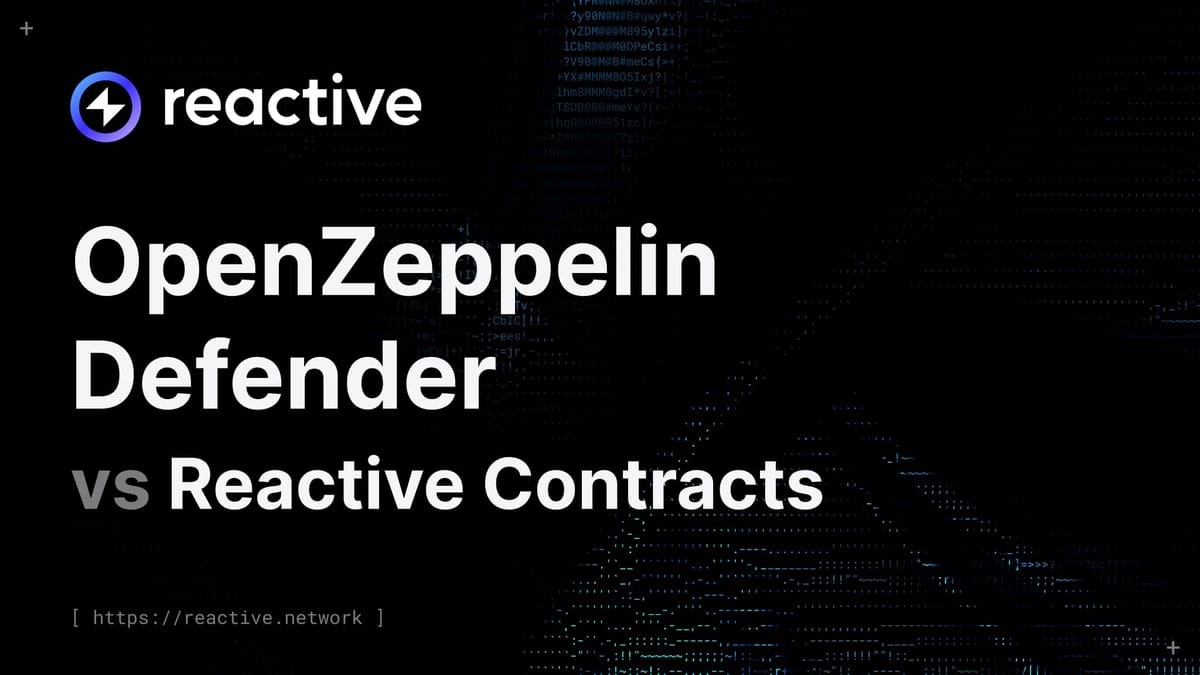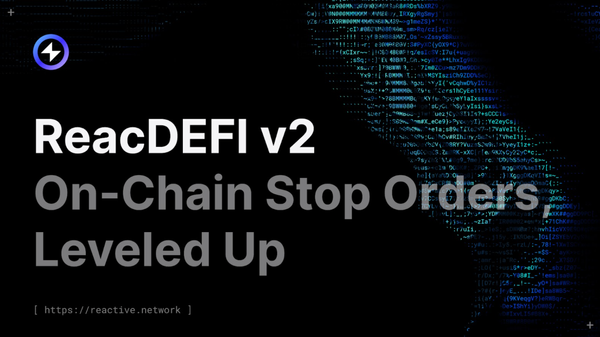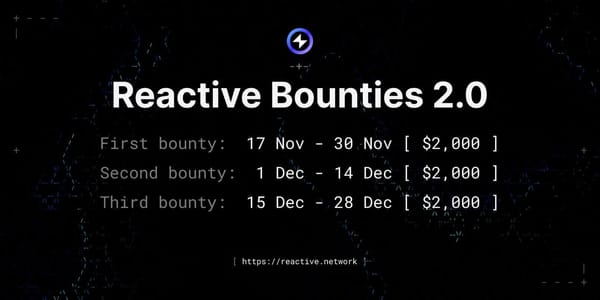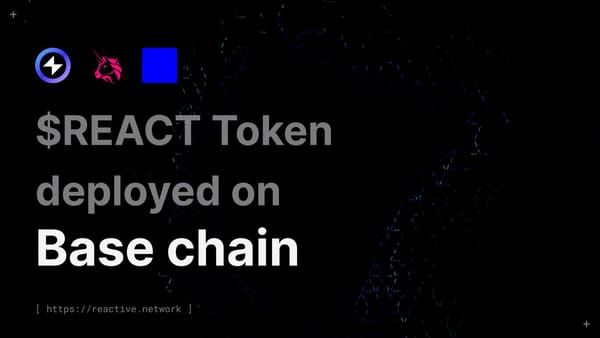OpenZeppelin Defender vs Reactive Contracts
OpenZeppelin Defender and Reactive Network both offer automation for smart contracts, but they serve very different needs. This article breaks down how Reactive’s event-driven, cross-chain architecture compares to Defender’s off-chain, scheduled automation.

Automation is fundamental to modern smart contract ecosystems. It ensures reliable execution, enables complex workflows, and reduces the need for manual interaction. Both OpenZeppelin Defender and Reactive aim to arm developers with smart contract automation — but they approach the problem in very different ways.
This article compares the two, focusing on design philosophy, technical capabilities, and ideal use cases — particularly in the context of dynamic and cross-chain environments.
Understanding OpenZeppelin Defender
OpenZeppelin Defender is a security-focused automation platform for Ethereum-based smart contracts. It provides developers with a set of tools to monitor contracts, relay transactions, and schedule function calls — all within a user-friendly dashboard.
It’s used by major DeFi protocols and security teams for operational tasks such as pausing contracts, triggering upgrades, or monitoring for risky behavior.
Key Features
Defender offers a modular, event-driven system built around the following components:
- Relayers: Funded entities that broadcast transactions on your behalf
- Scheduled Actions: CRON-based automation (e.g., every 5 minutes)
- Monitors: Event or function call detection with optional alerting
- Webhooks: Trigger actions from off-chain sources
- Notifications: Send alerts via email, Slack, or Telegram
These tools can be mixed and matched to create full automation workflows.
From a developer experience standpoint, OpenZeppelin Defender offers transparent logging and a detailed run history, making it easy to track automation behavior. The user interface is intuitive and provides a straightforward way to configure actions, monitors, and alerts without needing to write custom infrastructure. Importantly, developers can integrate automation without modifying the original smart contracts. However, the platform is best suited for single-chain setups, as it lacks native support for cross-chain workflows.
Limitations
Despite its polish and stability, OpenZeppelin Defender has several constraints. It does not support cross-chain execution, limiting its applicability in multi-network environments. More complex automation logic must be written in off-chain JavaScript, which can reduce transparency and introduce reliance on hosted infrastructure. Additionally, while Defender supports webhooks and workflows, these operate as external triggers and are not true on-chain automations — meaning they depend on off-chain systems to initiate contract interactions.
Setting Up Automation with Defender
Here are the tools required for setting up automation via Defender:
- Relayers – For sending gas-efficient transactions programmatically.
- Monitors – For tracking on-chain events and conditions.
- Actions – Automate task execution. These can be triggered via:
- Scheduled: Execute at fixed intervals.
- Monitor: Triggered when on-chain events occur.
- Webhook: Triggered via external HTTP requests.
- Workflow: Chain multiple actions together into automated sequences.
Contracts Used
Counter.sol
Notifier.sol
Workflow Summary
|
Step |
Description |
|
Scheduled Action |
Increments the |
|
Monitor |
Detects the |
|
Action |
Calls the |
Getting Started
Step 1: Visit https://defender.openzeppelin.com/
Step 2: Create a Relayer
Navigate to: Operate & Automate > Relayers > Create Relayer
- Provide a name
- Choose the network (e.g. Ethereum, Polygon)
- Choose Single or Grouped relayer
- Fund the relayer with ETH for transaction execution. The dashboard should look like this:
Creating a Scheduled Action
Navigate to: Operate & Automate > Actions > Create New Action > Trigger: Schedule
The following code runs on every scheduled call. It includes the contract address, encoded data, speed, and gas limit.
Select your relayer for transaction execution. Your run history should look like so:
Creating a Monitor + Action
This setup is similar to the scheduled action, but triggered by an on-chain event.
Webhooks
Webhooks trigger Defender actions via external HTTP requests. Everything remains the same except the trigger method.
Creating a Monitor
Navigate to: Operate & Automate > Monitors > Create Monitor
- Set a name
- Choose a risk category (optional)
- Enter contract address and ABI (or tag if unverified)
You can filter triggers by:
- Events and filter conditions
- Specific function executions
Select the event to monitor:
Set up a notification channel (e.g., Gmail, Slack, Telegram). In this example, Gmail is used.
Select the action linked to this monitor. Define an alert threshold (e.g., how many times it must trigger before alerting):
Outcomes
You logs and email should look respectively like so:
If gas limits aren't properly set in the action, failures may occur:
All automation logic is executed off-chain. Webhooks and Workflows are primarily for triggering from external systems, not for on-chain logic.
Understanding Reactive Contracts
Reactive Contracts are purpose-built for real-time, event-driven smart contract automation — especially in cross-chain environments. Instead of polling or scheduling, Reactive listens to events and responds dynamically across chains, enabling high-speed, deterministic workflows.
Designed for builders who need fine-grained control and full composability, Reactive eliminates the need for predefined conditions or off-chain logic.
Core Concepts
- Reactive triggers: Respond to on-chain events in real-time
- Cross-chain execution: Native support for source-destination workflows
- Composable architecture: Build adaptive logic without altering original contracts
- Transparent behavior: Deterministic and traceable execution paths
Reactive contracts are ideal for applications in DeFi, governance, cross-chain messaging, and real-time automation.
Feature Comparison
| Feature | OpenZeppelin Defender | Reactive Contracts |
|---|---|---|
| Automation Type | Scheduled or monitor-triggered | Event-driven, dynamic execution |
| Cross-Chain Support | ❌ Not supported | ✅ Built-in |
| UI | ✅ Intuitive and full-featured | ⚠️ Requires setup, but flexible |
| Contract Modification | ✅ No changes needed | ✅ Supports real-time event processing |
| Execution Logic | JavaScript (off-chain) | Fully on-chain event processing |
| Debugging Experience | ✅ Logs and history | ✅ Deterministic and traceable |
| Notification System | ✅ Built-in (email, Slack, Telegram) | ⚠️ Custom setup required |
Recap
OpenZeppelin Defender is an excellent tool for automating and monitoring contracts within a single EVM chain. Its polished UI, flexible alert system, and stable infrastructure make it a strong choice for security-critical or scheduled workflows. However, it's limited to off-chain JavaScript for complex logic, and it doesn't support cross-chain use cases.
Reactive Contracts, on the other hand, are built for composable, event-driven logic across networks. They provide full on-chain reactivity, cross-chain execution, and dynamic behavior — making them ideal for developers building advanced, real-time, or interoperable applications. While the learning curve is slightly steeper, the resulting flexibility and determinism offer long-term advantages.
About Reactive Network
The Reactive Network, pioneered by PARSIQ, ushers in a new wave of blockchain innovation through its Reactive Smart Contracts (RSCs). These advanced contracts can autonomously execute based on specific on-chain events, eliminating the need for off-chain computation and heralding a seamless cross-chain ecosystem vital for Web3’s growth.
Central to this breakthrough is the Inversion of Control (IoC) framework, which redefines smart contracts and decentralized applications (DApps) by imbuing them with unparalleled autonomy, efficiency, and interactivity. By marrying RSCs with IoC, Reactive Network is setting the stage for a transformative blockchain era, characterized by enhanced interoperability and the robust, user-friendly foundation Web3 demands.
Website | Blog | Twitter | Telegram | Discord | Docs





